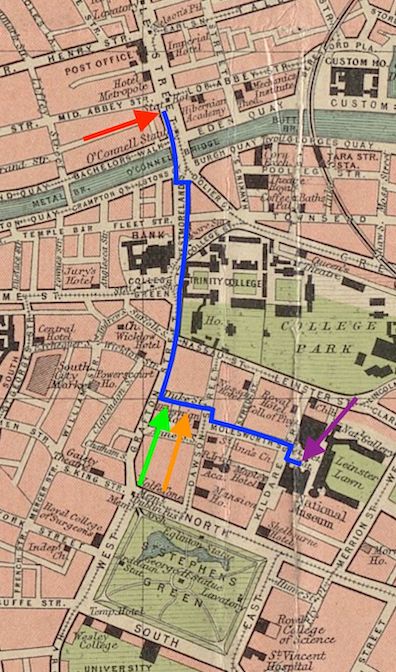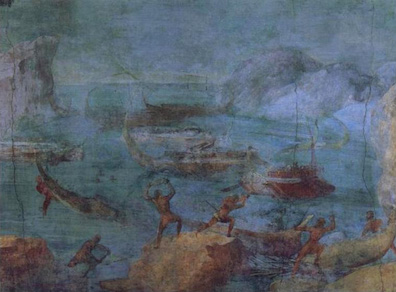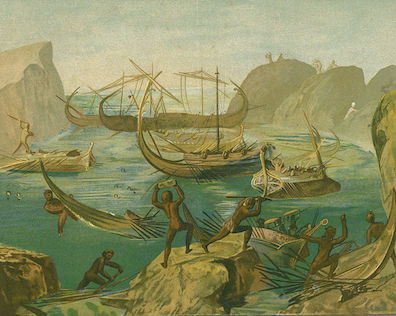Episode 8, called "Lestrygonians" in Joyce's schemas, presents a relatively
straightforward response to a short passage in Homer's Odyssey.
Having left the newspaper offices at about 1:00, Bloom strolls
southward down O'Connell, Westmoreland, and Grafton Streets
and then heads east along Duke and Molesworth Streets to end
up at the National Museum on Kildare Street. He is hungry. The
chapter begins with him pausing at a candy shop, taking in its
smells. As he walks on he sees famished people, and people
selling food. Eventually he finds a place to have lunch, after
being nauseated by the ambience of the first restaurant he
enters. Inspired by the Homeric analogue, the chapter's prose
relentlessly throws up figures of food, hunger, eating,
digestion, excretion, baiting, feeding, killing, and
cannibalism. Reflecting on food's passage down the alimentary
canal (echoed by his own long passage down urban corridors
hemmed in by large buildings, at the end of which he will
search for a statue's anus), Bloom thinks also of time's
passage and the changes it wreaks in human lives.
In book 10 of Homer's epic, just after the story of Aeolus
and the winds, Odysseus recounts how his men rowed for six
days to reach the land of Laestrygonia, where they found a
harbor like a mouth:
We reached the famous harbor, all surrounded
by sheer rock cliffs. On each side, strips of shore
jut out and almost meet, a narrow
mouth. (88-90)
Most of the ships dropped anchor inside this harbour, but
Odysseus cautiously moored his vessel just outside it. Three
men were dispatched to go inland and see who lived there. They
met a girl fetching water—the daughter of the king,
Antiphates—and she took them back to the palace, where her
mother, a giant, grabbed and ate one of the men. A force of
giants led by her father pursued the other men back to the
harbor, wrecked the anchored ships by bombarding them with
huge boulders, and speared the floating sailors for supper.
Only Odysseus and his crew escaped.
Since Joyce identified the art of his chapter as
"architecture," it seems likely that he meant for the imposing
buildings flanking Bloom as he walks—the Ballast House, the "surly
front" of Trinity College, the Bank of Ireland, the canyon of
Grafton Street, the bend into Duke Street—to evoke the cliffs
that frame the Lestrygonian harbor. Other details in the two
schemas neither require conjecture nor add much to the
impressions that any attentive reader will take from the
chapter's prose. The Linati schema identifies the color of the
chapter as "sanguigno" (blood-red), the technique as
"peristaltic prose," the organ as the "esophagus," and the
symbols as "bloody sacrifice: food: shame." The Gilbert schema
adds a correspondence between the Lestrygonians and "Teeth."
In addition to countless mentions of food, most of them
benign and some wonderfully funny, Joyce's chapter features
some decidedly dark thoughts about the brutal business of
eating. As in many other chapters of Ulysses, the
violent interpersonal conflicts of Homer's poem are recast as
conflicts within the human psyche. Bloom is horrified by
meat-eating in Lestrygonians, but his modest
vegetarian lunch does not begin to absolve him of his species'
carnivorous murderousness. Feeling compassionate sympathy for
butchered cows and sheep, as he does, does not change the fact
that he and most of his kind regularly eat them.
Other animals are no different. When he feeds some gulls from
the O'Connell Bridge, moved by pity for "Those poor birds,"
Bloom becomes "Aware of their greed and cunning" and does not
waste a second penny. Life on earth inevitably involves taking
life from others, and thinking of the whole bloody business
can leave even the cannibals at the top of the food chain
feeling cannibalized: "This is the very worst hour of the day.
Vitality. Dull, gloomy: hate this hour. Feel as if I had been
eaten and spewed." The Linati schema identified the
Sense/Meaning of the 8th chapter as "L'abattimento"
(dejection, despondency).
Although Bloom has no particular horror of the stuff that
comes out of the intestines (rather the contrary), he does
feel discouraged by the unending daily need to eat: "stuffing
food in one hole and out behind: food, chyle, blood, dung,
earth, food: have to feed it like stoking an engine." The
cyclicality of food becoming waste and re-entering the mouth
reconstituted as food has been anticipated earlier as he stood
on the bridge, gazing at the feces-laden Liffey: "If I threw
myself down? Reuben J's son must have swallowed a good
bellyful of that sewage." The alimentary channel forms a torus
through which the physical environment flows uninterrupted.
Eater and eaten, food and excrement, make up an endlessly
repeated cycle.
The elemental need to fill one's stomach day after day
discourages Bloom. In one brief passage of a few paragraphs,
he thinks of how dinner invitations bait young men into
joining the revolutionary cause; how trams and policemen go in
and out, in and out, every day of the year; how dead bodies
are "carted off," and screaming babies "tugged out," every day
of the year; how an entire "cityful" of people is replaced
with a new "cityful" of people, over and over again; how
cities themselves, and their wealth, are "worn away age after
age." His conclusion: "No one is anything." Even planets and
stars wink in and out: "Same old dingdong always. Gas: then
solid: then world: then cold: then dead shell drifting around,
frozen rock, like that pineapple rock." Later, his
contemplations of transience become personal as he remembers
kissing Molly on Howth Head and accepting the chewed seedcake
from her mouth while a nannygoat walked by, "dropping
currants." The passage of food reminds him that the passage of
ten years has destroyed his marital happiness: "Me. And me
now."
Aeolus announces the coming end of what Joyce called
the "initial style" of his novel: experimental but still
recognizably conventional third-person objective narration,
stuffed with interior monologue and with free indirect
discourse that pulls the narrative into the orbits of
particular characters' thoughts. The all-caps headline-like
titles of the newspaper chapter are the first of many bold
departures from this initial style. Subsequent chapters
explore entirely new ways of telling the story, but Lestrygonians
affords a pause. Like the relief that Calypso offers
to the exhausted reader of Proteus, this chapter draws
back from the strangeness of Aeolus to offer one last
experience of a by-now accustomed mode of narration. It is an
oasis of familiarity before the coming disorientations.



